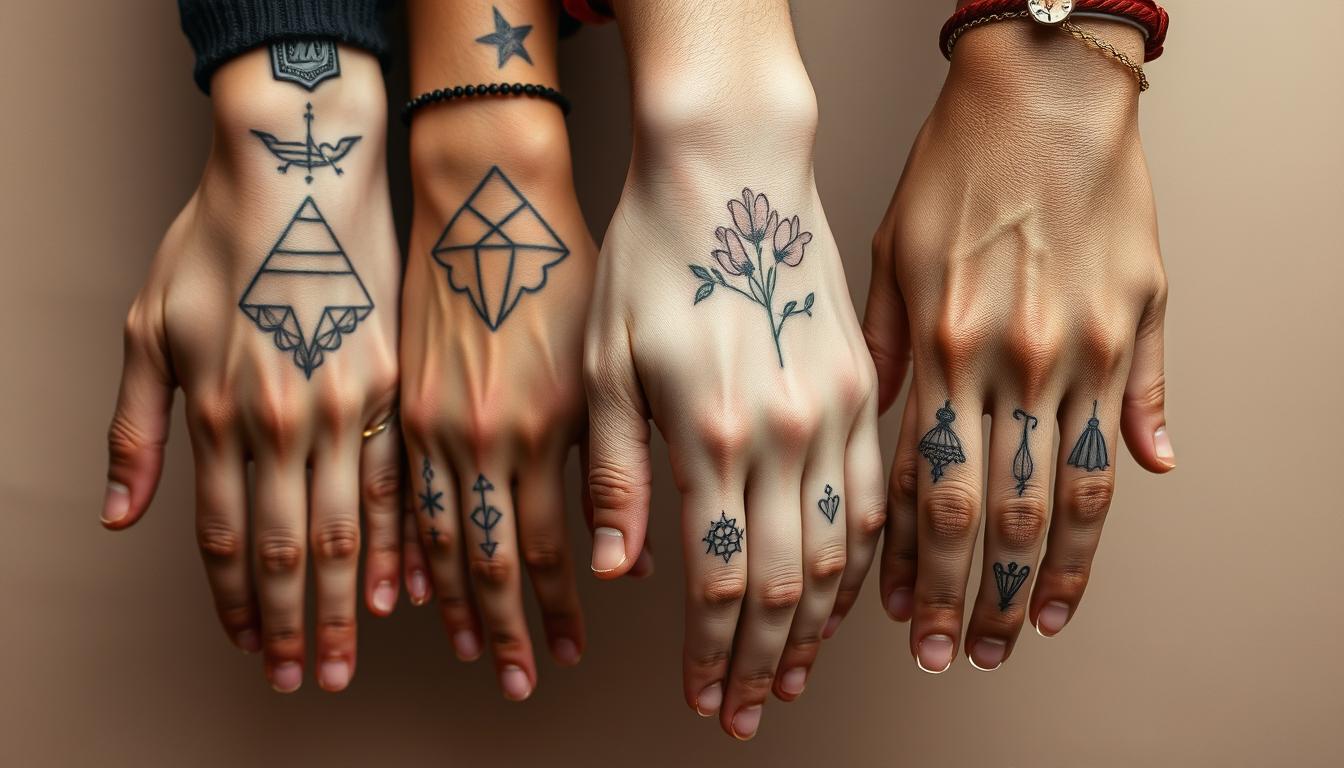
Hand tattoos have become a significant form of self-expression in contemporary tattoo culture. From ancient tribal traditions to modern trends, hand tattoos have left an indelible mark on the world of body art.
The visibility and uniqueness of tattoos on the hand make them a popular choice for those looking to showcase their personal style. With various placement options, including the back of the hand, palm, and fingers, individuals can choose a design that suits their taste. For instance, artists like XXXTentacion have used hand tattoos to convey personal symbols and meanings, highlighting the significance of this form of body art.
Key Takeaways
- Hand tattoos are a growing trend in contemporary tattoo culture.
- Various placement options are available, including the back of the hand, palm, and fingers.
- Designs range from minimalist to elaborate, offering something for everyone.
- Pain levels and healing considerations should be taken into account before getting a hand tattoo.
- Professional implications and aftercare commitment are crucial factors to consider.
The Rich History of Hand Tattoos
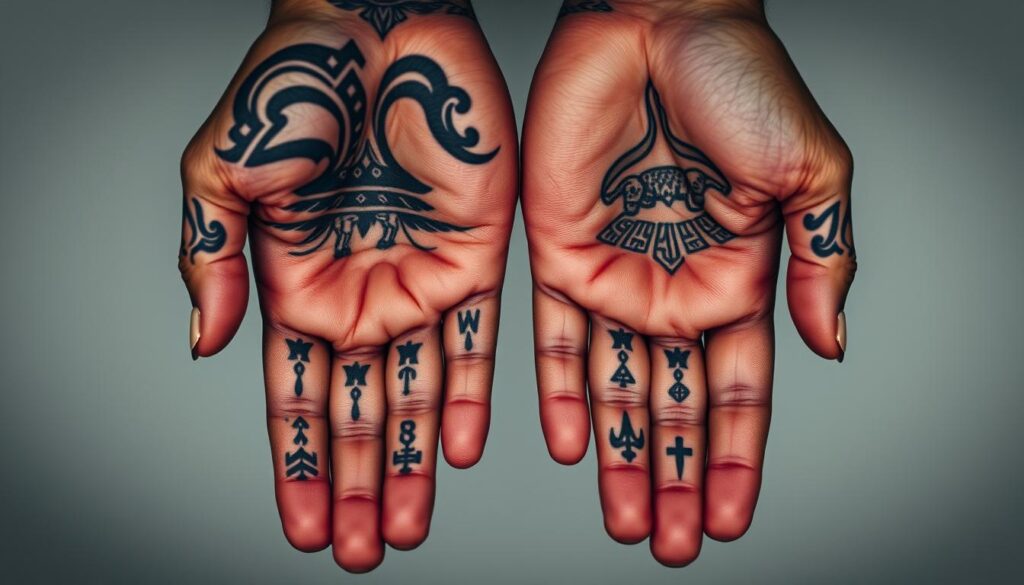
For centuries, hand tattoos have served as a canvas for cultural identity, spiritual beliefs, and personal expression. The intricate designs and patterns that adorn the hands have been a part of various cultures, telling stories of heritage and significance.
Ancient Origins and Cultural Significance
The origins of hand tattoos date back thousands of years, with evidence found in ancient civilizations such as Egypt, where mummies were discovered with tattooed fingers. These markings were believed to carry significance in the afterlife. Across the Pacific, Polynesian cultures, including the Maori and Samoans, used hand tattoos as powerful symbols of identity, lineage, and social status.
The cultural significance of hand tattoos varied across societies, serving as marks of protection, status, or religious devotion. Traditionally, these tattoos were created using primitive tools and natural pigments, highlighting the artistry and craftsmanship of ancient cultures.
Evolution in Modern Tattoo Culture
In modern times, hand tattoos have evolved from being associated with specific subcultures to becoming mainstream fashion statements. The influence of celebrities and social media has played a significant role in their increased popularity and acceptance. Today, hand tattoos are a form of body art that allows individuals to express their personal style and identity.
The evolution of hand tattoos reflects broader changes in tattoo culture, with advancements in technology and technique making tattoos more accessible. As a result, hand tattoos have become a popular choice for those looking to make a statement with their tattoo art.
Understanding Different Hand Tattoo Placements
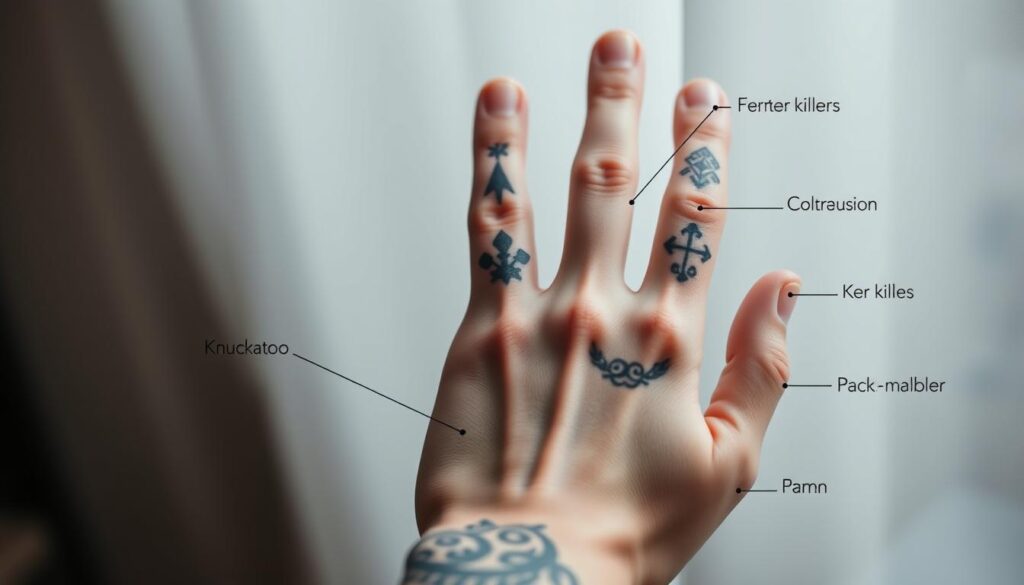
The placement of a hand tattoo can significantly impact its appearance and longevity. Different areas of the hand present unique challenges and opportunities for tattoo design.
Back of Hand Tattoos
Tattoos on the back of the hand are visible and can be a bold statement. The back of the hand has thin skin over bones and tendons, making the tattooing process potentially painful. Designs that work well in this area include geometric patterns and symbolic imagery. For more information on back tattoos, you can visit https://nailcutandink.com/back-tattoos-for-men/.
Palm Tattoos
Palm tattoos are unique due to the area’s high sensitivity and constant use. The pain level for palm tattoos can be intense, and the design may fade faster than in other areas. Simple, bold designs are recommended for palm tattoos.
Finger Tattoos
Finger tattoos have gained popularity and can be placed on the sides, tops, or between fingers. The small canvas requires minimalist designs. Finger tattoos are prone to fading due to constant exposure and use.
| Hand Tattoo Placement | Pain Level | Design Considerations |
|---|---|---|
| Back of Hand | High | Geometric, Symbolic |
| Palm | Very High | Simple, Bold |
| Finger | Variable | Minimalist |
Popular Hand Tattoo Designs and Their Meanings
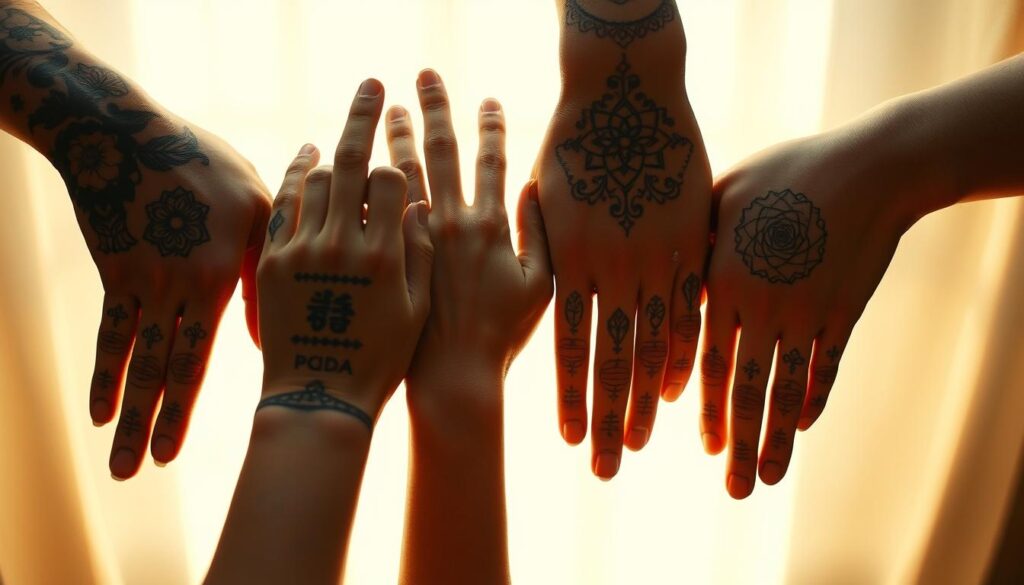
With their visibility and versatility, hand tattoos have become a favored choice for showcasing meaningful designs. Hand tattoos offer a unique canvas for self-expression, allowing individuals to convey their personality, values, and experiences through various artistic styles.
Symbolic and Spiritual Designs
Symbolic and spiritual designs are popular for hand tattoos, as they often carry deep personal significance. These designs can include religious symbols, protective emblems, and cultural motifs that represent an individual’s beliefs or heritage. For instance, a cross on the hand can symbolize faith, while a Hamsa hand is believed to offer protection against evil.
Minimalist and Geometric Patterns
Minimalist and geometric patterns have gained popularity in hand tattoo designs due to their clean and simple aesthetic. These designs work particularly well on the hand, as they can be easily adapted to fit the limited canvas. Geometric shapes like triangles and mandalas are often used to represent balance and harmony.
Traditional and Neo-Traditional Styles
Traditional and neo-traditional tattoo styles have been adapted for hand tattoos, offering classic imagery with a modern twist. Designs like roses, daggers, and skulls are popular choices, symbolizing various aspects of life such as love, strength, and mortality.
Text and Quote Tattoos
Text and quote tattoos on hands are a meaningful way to display personal mantras or significant words. The choice of font and placement is crucial, as it affects the overall appearance and readability of the tattoo. Popular choices include inspirational quotes, names, or dates that hold personal significance.
| Design Style | Characteristics | Symbolism |
|---|---|---|
| Symbolic and Spiritual | Religious symbols, protective emblems | Faith, protection, cultural heritage |
| Minimalist and Geometric | Simple shapes, patterns | Balance, harmony |
| Traditional and Neo-Traditional | Classic imagery, bold lines | Love, strength, mortality |
| Text and Quote | Personal mantras, significant words | Inspiration, personal significance |
The Pain Factor: What to Expect
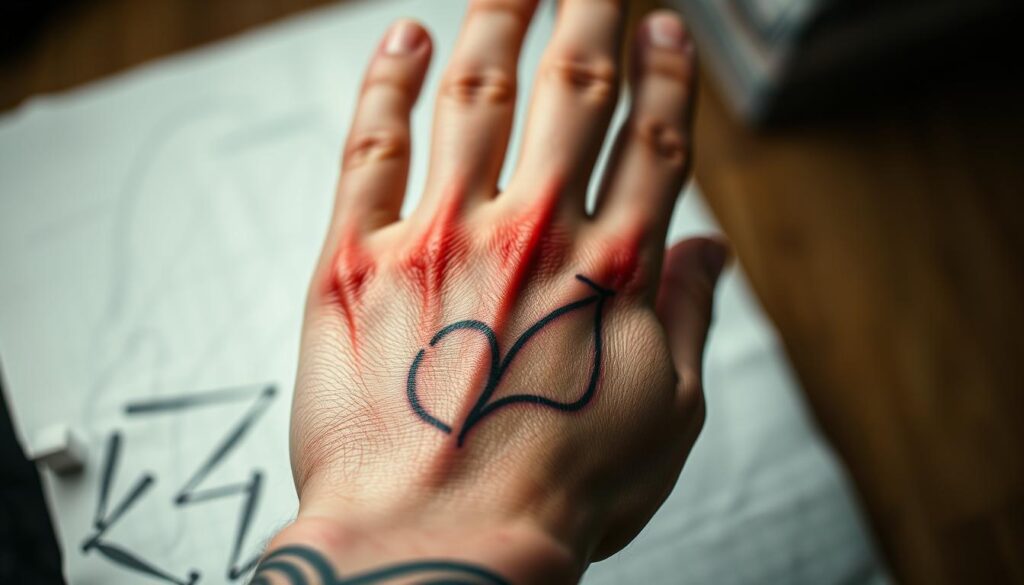
Getting a hand tattoo can be a painful experience due to the area’s anatomy. The hand has thin skin, numerous nerve endings, and bones close to the surface, making it a sensitive area for tattooing.
Pain Levels for Different Hand Areas
The pain level varies across different areas of the hand. The palm is typically the most painful due to its thick skin and high concentration of nerve endings. Fingers and knuckles are also quite sensitive, while the back of the hand is relatively less painful but still uncomfortable. Understanding these differences is crucial for preparing oneself for the tattooing process.
Pain Management Techniques
Several techniques can help manage pain during hand tattoo sessions. Using topical numbing creams can reduce discomfort. Staying hydrated, eating before the session, and practicing mental preparation strategies, such as deep breathing or meditation, can also help alleviate pain. Experienced tattoo artists often provide guidance on how to prepare for the discomfort, making the experience more manageable.
Professional Considerations Before Getting Hand Tattoos

Professional considerations play a significant role in the decision to get hand tattoos. While tattoos have become more accepted in the workplace, some industries and employers still maintain conservative attitudes towards visible tattoos, especially those on the hands and fingers.
Workplace Policies and Visibility
The visibility of hand tattoos can significantly impact professional opportunities. Unlike tattoos in other areas, hand tattoos are difficult to conceal in most workplace settings. It’s essential to research your company’s dress code policies and understand how visible tattoos are perceived. In conservative industries like finance, law, or government, visible tattoos may still be frowned upon.
Industry-Specific Considerations
Different industries have varying levels of acceptance for visible tattoos. Creative industries and startups often value individuality and self-expression, making them more accepting of tattoos. On the other hand, traditional industries may have stricter policies. Consider your current and future career paths when deciding to get hand tattoos. It’s also crucial to think about how your decision might affect your long-term career flexibility.
Choosing the Right Artist for Hand Tattoos
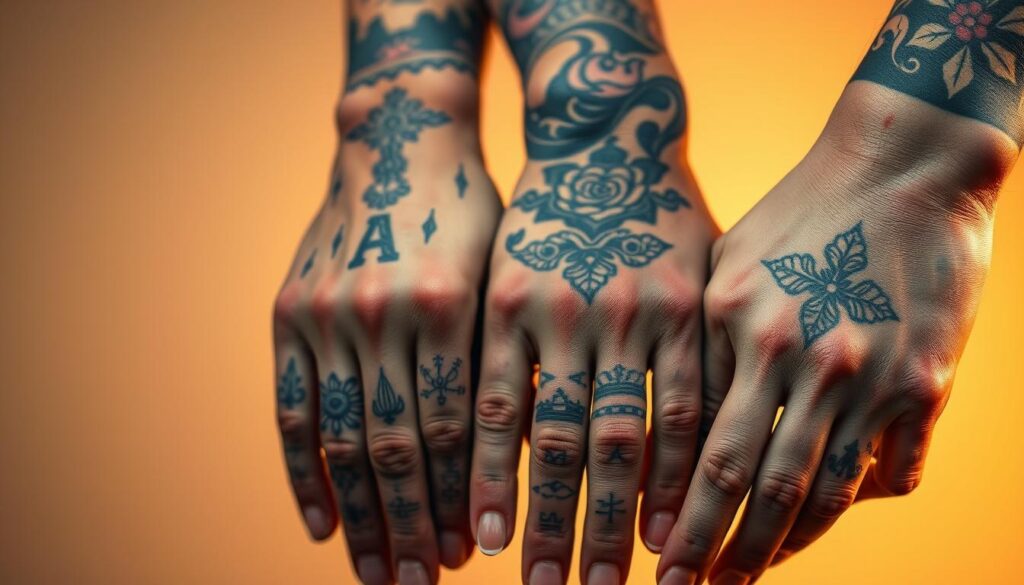
Selecting the right tattoo artist for hand tattoos is crucial due to their delicate nature. Hand tattoos require an artist with specialized skills and experience.
Experience and Specialization
Not all tattoo artists are qualified or willing to work on hand tattoos, especially for clients without existing tattoos. An experienced artist understands the unique challenges of hand skin and the techniques required for precision and clarity. When searching for an artist, look for those with a portfolio that showcases their hand tattoo work. It’s essential to find an artist who has specific experience in this area.
| Artist Qualities | Importance |
|---|---|
| Experience with Hand Tattoos | High |
| Portfolio Quality | High |
| Client Reviews | Medium |
Portfolio Assessment
Assessing a tattoo artist’s portfolio is critical. Look for clean lines, proper healing, and longevity in their previous hand tattoo pieces. You can also ask potential artists about their techniques, ink choices, and aftercare recommendations. Building a relationship with the artist before requesting hand work can be beneficial, potentially starting with other tattoos to establish trust.
The Tattooing Process for Hand Tattoos
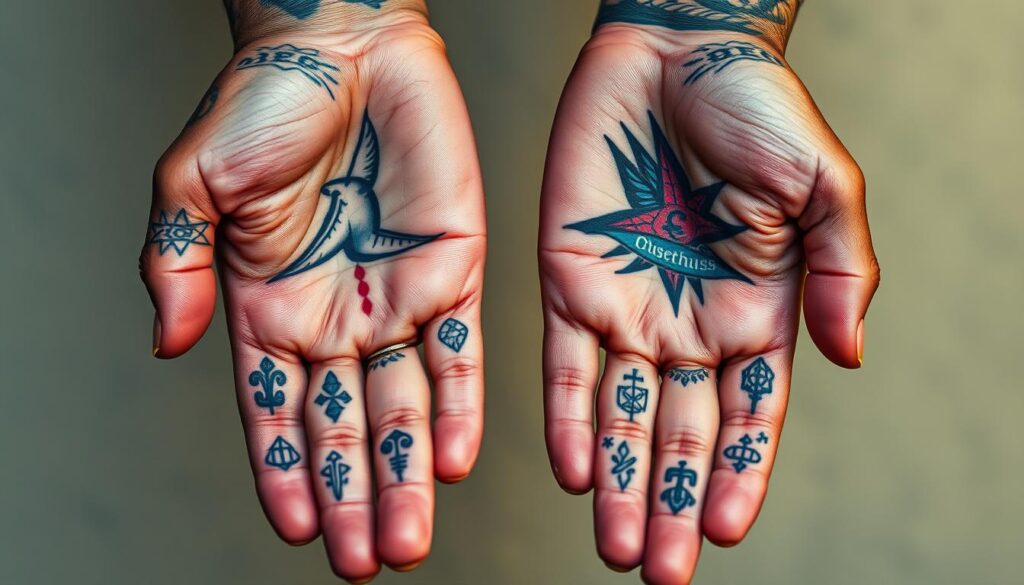
The journey to getting a hand tattoo begins long before the actual tattooing session, with preparation being key. Understanding the steps involved in getting a hand tattoo can make the experience less daunting and more enjoyable.
Preparation Steps
Before your tattoo session, it’s crucial to prepare your hand properly. This includes ensuring the area is clean and shaven. If you have hair on the back of your hand, gently shave it to avoid any razor burn. Additionally, maintaining good hygiene, avoiding sun exposure, staying hydrated, and avoiding alcohol or blood-thinning medications are recommended. Proper preparation can significantly impact the quality of your tattoo and the overall experience.
What Happens During the Session
During the tattoo session, your artist will first create a stencil of the design on your hand. The actual tattooing process requires you to remain as still as possible, despite the discomfort. Your artist may ask you to take breaks if needed. The session’s duration can vary, but hand tattoos often require shorter sessions due to the pain factor. After the tattoo is complete, your artist will provide aftercare instructions and wrap the tattoo to protect it.
Aftercare and Healing for Hand Tattoos

Given the daily wear and tear on our hands, aftercare for hand tattoos is particularly important. The constant use and exposure of our hands to various elements make them more susceptible to complications during the healing process.
Immediate Aftercare
Proper immediate aftercare is crucial for the healing of hand tattoos. This includes keeping the tattoo clean with mild soap and lukewarm water, applying a thin layer of ointment to keep the tattoo moisturized, and avoiding direct sunlight and harsh chemicals. It’s essential to resist the urge to scratch, as this can lead to infection or damage to the tattoo. Wearing gloves during activities that involve dirt or chemicals can protect the tattoo.
Long-term Care and Maintenance
After the initial healing process, long-term care is necessary to maintain the quality and appearance of hand tattoos. This involves regular moisturizing to keep the skin hydrated, using sunscreen to protect against UV damage, and considering touch-ups as needed over the years. Regular care can significantly extend the life and vibrancy of the tattoo. It’s also important to be aware that hand tattoos may require more frequent touch-ups due to the constant use and exposure of the hands.
Conclusion: Making Your Decision About Hand Tattoos
With hand tattoos being highly visible, careful consideration is necessary before taking the plunge. A hand tattoo is a personal statement that others will see frequently, so it’s crucial to think about what you want to display to the world. Considering the season when getting a hand tattoo is also important, as you’ll need to protect it from the sun during healing.
To make an informed decision, weigh the aesthetic appeal of hand tattoos against professional considerations and maintenance requirements. Ask yourself questions about your career plans, pain tolerance, and commitment to aftercare. If you’re uncertain, consider alternatives like temporary tattoos or less visible placements. Ultimately, hand tattoos can be a beautiful form of self-expression, but they require responsibility and careful thought.
